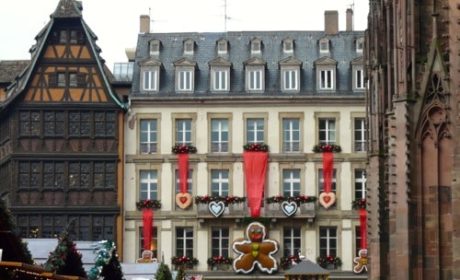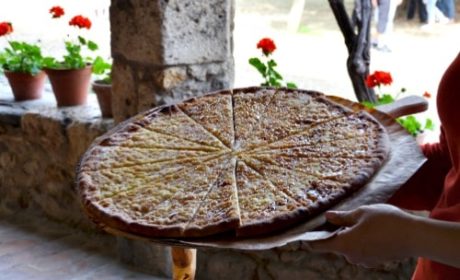Did someone say road trip? A Champagne Country road trip is a must-do for the serious champagne enthusiast. Combining a glass of bubbly with a drive through the scenic French countryside, well what could be better?
From north to south and east to west, France is a treasure trove of scenic road trips. Especially renowned for its expansive hills of vineyards, the country is always a favorite of serious oenophiles.
Although many countries throughout the world offer spectacular wine regions to visit, France’s Champagne region is truly unique. My Itchy Travel Feet featured writer, Debi Lander from ByLanderSea, shares her tips for taking a mother-daughter road trip through Champagne country.
Table of Contents
Mother-daughter Champagne Country road trip
I’d describe my daughter Laura as a champagne girl. She likes to taste the finer things in life, with champagne one of her favorites. She’s also a first level sommelier; so making a sojourn to the champagne region of France became a must-add to our Mother/Daughter Paris itinerary.

The Champagne region of France lies between Paris to the west, Belgium to the north and Lorraine to the east. We designed our regional tour based on the brands Laura most wanted to visit, as I’m okay with any champagne.
The plan called for a visit to Reims the first day and Epernay the next, the two cities known as capitals in the champagne district. Boarding a TGV high-speed train in Paris, we arrived in Reims about 45 minutes later. Once settled in our rental car, we soon came to the first of the big champagne houses, Taittinger.
Boomer Travel Tip
Considering traveling independently through Europe? Start your research with our European road trip planner.
A Tasty Trip to Taittinger

Taittinger, like most, offers tours and provides introductory remarks, where the talk is all grapes. We learned that producing champagne requires strict adherence to complex rules.
Wine can only be labeled as “champagne” if made in the Champagne appellation (region) of France. Second, to be called “champagne,” the crush must consist of only the Pinot Noir, Pinot Meunier, or Chardonnay grapes grown within the region.
And third, real champagne, as opposed to other sparkling wines, must be fermented twice: once in barrels, and again in bottles. The process produces those effervescing bubbles, kept in check by a daily, slight turn to each bottle during production.

A short film about the Taittinger brand followed, describing the company founded in 1734 and still controlled by the original family. Our guide then led the group down many steps and through the cellars, but elevators were available for those that preferred.
The underground world amazed me. We walked through the remnants of the old Saint Nicaise Abbey, dating back to the 13th century. Descending more stairs, we reached Gallo-Roman era chalk vaults carved out of the hillsides. I’d describe the walls as aptly chalky white in color and the surroundings as cool and damp.

The Romans used chalk for construction, excavating these cavern-like rooms and tunnels for materials. Champagne makers prefer the chalk chambers for very different reasons—the constancy of the underground temperature (about 53 degrees Fahrenheit year-round); the sponge-like quality of the chalk, which soaks up humidity and keeps it at an equally constant 88 percent; and the absence of light and vibration.

However, during WWI, the labyrinth of caves served a different purpose. Reims suffered heavy bombardment.
Nearly all the residents not fighting in the war took refuge in the caves. They established schools, hospitals, and churches around the maturing bottles of champagne.

The resilient community survived, but poignant drawings and chiseled names on the walls speak to the longings and fears of those cloistered underground. For me, the scratched designs made history real and gave me an appreciation of the wartime struggles.

We continued with our tour, passing the cellars where Taittinger ages its famous prestige cuvée, Comtes de Champagne. The crayères (caves) go on for miles, creating an astounding storage facility for millions of bottles of champagne.
The rewards of a visit don’t end with the tour; a delightful tasting (or two) follow, typically near the gift shop where visitors can buy bottles of the bubbly or other logo-emblazoned items. To my untrained palate, the Taittinger tasted light and fruity.
Boomer Travel Tip
MedjetAssist Members who are hospitalized 150 miles from home receive medical transport to a home-country hospital of choice. Memberships from $99.
Voyage to Veuve Cliquot

After lunch nearby, we drove to Veuve Cliquot, Laura’s favorite brand. Its unmistakable yellow label, one of the most well-known champagnes marketed today, comes up in James Bond novels, “Downton Abbey,” and, well, even in the “Real Housewives.”
The guide’s telling of the following story made me a huge fan too. She explained that the “Veuve (Widow) Clicquot” took over her husband’s champagne house at the age of 27 after his unexpected death. She improved the production procedures and became a businesswoman far ahead of her time.
Madame Clicquot wanted to reduce the buildup of bubbles in the unopened wine during the second fermentation. She believed that rotating the bottles would help, and asked her cellar master to turn them slightly every day.
The method worked. This so-called “riddling” has become mechanized, with only the most prestigious houses turning their bottles by hand.
The House of Clicquot also perfected a procedure called “disgorgement.” The vintners uncork the bottles during the second fermentation to dislodge the yeast sediment that accumulates.
Storing the bottles at an angle allows the sediment to settle in the neck. Upon releasing the cork, pressure expels the sediment from the bottle. An expert “disgorger” must then quickly re-cork the bottle before losing any of the precious bubbly.
Boomer Travel Tip
Tilar J Mazzeo has written a fascinating biography of The Widow Cliquot.
Madame Clicquot struggled through five years of bad vintages, war, and near-failure – finally celebrating success in 1810 with her first single-vintage Champagne. The concept quickly proved a huge success when the iconic 1811 vintage Champagne was labeled ‘The Year of the Comet.’
To be named vintage champagne, the grapes harvested from a specific year must be considered such extraordinary quality; they need not be blended with wine from other years. For her innovations, Madame Cliquot went on to fame as one of the “grand dames” of champagne.

A stairway leading up from the Cliquot cellars denotes each year the company proclaimed vintage champagne. Laura noted and proudly stood on her birth year, 1991. Naturally (and wonderfully), the tour ended with a tasting, this time the scrumptious Brut Yellow Label cuvée.
We were careful to allow time to absorb the alcohol before driving, the consequence being a great deal of time (and money) spent in the gift shop!

Finding our hotel, the exceptional Château de Rilly, took a circuitous expedition with stops for vineyard photos along the way. But, once there, we became enchanted with the splurge-worthy property near Reims.
Later, we dressed and feasted in the hotel’s formal dining room on a wine paired meal. Happy and full, we soon called it a night.
Adventures in Epernay
Next morning we were off to Epernay, searching for the Avenue du Champagne, the street that Winston Churchill named “the world’s most drinkable address.” Beneath the pavement of Epernay lies nearly 70 miles of subterranean cellars and more than 200 million bottles of Champagne.
In 1950 the Mercier cellar alone, (we would visit later), hosted a car rally without the loss of a single bottle. I was flabbergasted to think we were driving over such precious treasure.

First stop in Epernay was the statue of Dom Perignon outside the house of Moet & Chandon. Champagne lovers have the famous monk to thank for creating the tasty, tingly treat.
The Dom Perignon story begins with the near-blind Benedictine monk functioning as the abbey’s cellar master. He considered his abbey’s wine adequate but pale. He feared that neighboring deep red wine in “Bourgogne” (Burgundy), was gaining favor with the King.
But, temperatures too cold in the region during the winter precluded production of a “proper “red. The chilly winter temporarily halted the fermentation process, with the warmer spring climate “reawakening” fermentation in the bottles to produce bubbly wine.

Perignon and his abbey brothers were frustrated by the bubbles, and began altering the wine’s chemistry. Blending several types of grapes and removing the skins, they ended up creating the first white wine. Unfortunately, this new elegant pale wine persisted in fermenting after it was bottled!
The bubbles also caused the bottles to explode all over the cellars. Persevering, Perignon began by changing the shape of the bottle and using heavier glass.
The stronger bottle eliminated the explosion problem, but the effervescence persisted in blowing out the stoppers. Perignon turned to Spain for cork and eventual success! The king’s court was as delighted as we are today.

The Moet & Chandon tour proved much like those in Reims (no problem there), and we began to understand more of the details of the production process. Still, each house tells its own story; Moet’s recalls hosting Napoleon in 1807. We also caught sight of the storage location for the treasured Dom Perignon bottles.

After tasting and exiting the gift shop, we popped across the street to the showroom at Perrier-Joulet. No tours, but their gorgeous hand-painted bottles offered an explosion of colors, well worth a look.

We strolled up and down the Avenue, thoroughly taking in the wealthy town and flowering gardens. After lunch, we visited the surprising Mercier facility.
Boomer Travel Tip
In today’s travel climate, trip insurance is a must. Compare policies and rates at InsureMyTrip.
Meandering around the Mercier Facility

Eugene Mercier was an ambitious dreamer. In 1858, at age 20, he had no money, no vines and no family connection with the Champagne houses.
Undaunted, he shook up traditions to create less costly champagne—one for all occasions. He joined with four winegrowers to reduce costs by producing and selling their wine together, a technique widely accepted by the 20th century and continuing today.
This non-conformist became the force behind some spectacular 19th-century events, including Mercier champagne tasting in a hot air balloon. We saw and heard the story of the 20-ton barrel that took 24 oxen and 18 horses to cart from Epernay to Paris for the 1889 Exposition. It could hold the equivalent of 200,000 bottles of champagne.

The Mercier cellars were the first to be constructed according to a plan based on architectural drawings, designed at the outset to be open to the public. The high arched ceilings, the sculpted décor, and theatrical touches make for an exciting tour, different from the others. It’s very family friendly, and the many stories are fun and full of adventure.
Visitors ride a little train through the cellars and pass many bas-reliefs and sculptures carved into the walls. The champagne’s taste, to me, was not as good. But, if you visit Epernay, take the tour.
We spent the second night at Chateau de Rilly, enjoying another fabulous meal in the dining room. The next morning, before returning to Paris, we stopped in Reims to visit Maison Mumm.
Sipping on Mumm Cordon Rouge

We listened to Mumm’s history and drank Mumm Cordon Rouge from a delicate glass flute. I enjoyed the museum toward the end of the tour, with its display of vintage tools for cultivating grapes and producing wine. Laura loved the tower of champagne goblets.
Visiting the Reims Cathedral
We couldn’t leave Reims without stopping at the famous Reims Cathedral. After considerable trouble finding a parking space, we approached. The exterior was partially under renovation, and unfortunately, the interior was even more cluttered by scaffolding.
Disappointed, I still got the feel of its vast size and an eyeful of its magnificent Rose Window. We heard that the sound and light shows projected onto the façade in the summer are fantastic.

We nearly missed our return train, due to the rental car company closing for lunch from noon to two and offering no place to return the keys. We all out ran to catch our train; ending our marvelous excursion huffing and puffing like the Big Bad Wolf. Soon, however, some more champagne put a cork in our cask-full of wonderful memories.
Tips for Visiting the Champagne Houses
- Study a map and choose the houses you want to visit. Cost varies, so check the website for options.
- Making reservations for the tasting tours proved somewhat tricky. In 2016, few online options were offered, but more are now available. Taittinger allows drop-in visits, but very few other producers do. Worse yet, the tours fill up days ahead of time. My tip is to stay in a hotel within the region, and ask them to call and reserve space.
- Carry a sweater or dress warmly as the temperature in the cellars ranges from 46-54°F.
- Wear comfortable walking shoes, because the cellars are dark and can be slippery.
- It is possible to take taxis in Reims and Epernay, but a rental car provides the most flexibility.
- Many houses are closed during the winter months, check their websites prior to a visit.
How to plan your champagne road trip through the French countryside
A little research goes a long way when planning a trip to France’s Champagne region. Check out our recommended resources for researching your trip:
- Research flights to Paris to find the best-priced flight for your trip: Free flight comparison at Kayak.
- Browse through the hotels in France listings at TripAdvisor (be sure to read the reviews) to find the perfect accommodations for your trip.
- Book ahead for the G.H. Mumm Cellar Tour and Tasting.
And we’ve researched tour options for our luxury travel readers who prefer to let someone else do the driving while they do the champagne sipping:
Save to Pinterest




